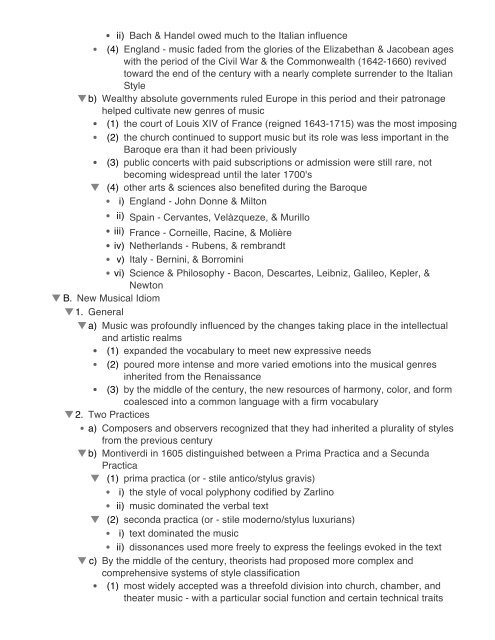An Outline of The History of Western Music Grout ... - The Reel Score
An Outline of The History of Western Music Grout ... - The Reel Score
An Outline of The History of Western Music Grout ... - The Reel Score
You also want an ePaper? Increase the reach of your titles
YUMPU automatically turns print PDFs into web optimized ePapers that Google loves.
ii) Bach & Handel owed much to the Italian influence<br />
(4) England - music faded from the glories <strong>of</strong> the Elizabethan & Jacobean ages<br />
with the period <strong>of</strong> the Civil War & the Commonwealth (1642-1660) revived<br />
toward the end <strong>of</strong> the century with a nearly complete surrender to the Italian<br />
Style<br />
b) Wealthy absolute governments ruled Europe in this period and their patronage<br />
helped cultivate new genres <strong>of</strong> music<br />
(1) the court <strong>of</strong> Louis XIV <strong>of</strong> France (reigned 1643-1715) was the most imposing<br />
(2) the church continued to support music but its role was less important in the<br />
Baroque era than it had been priviously<br />
(3) public concerts with paid subscriptions or admission were still rare, not<br />
becoming widespread until the later 1700's<br />
(4) other arts & sciences also benefited during the Baroque<br />
i) England - John Donne & Milton<br />
ii) Spain - Cervantes, Velàzqueze, & Murillo<br />
iii) France - Corneille, Racine, & Molière<br />
iv) Netherlands - Rubens, & rembrandt<br />
v) Italy - Bernini, & Borromini<br />
vi) Science & Philosophy - Bacon, Descartes, Leibniz, Galileo, Kepler, &<br />
Newton<br />
B. New <strong>Music</strong>al Idiom<br />
1. General<br />
a) <strong>Music</strong> was pr<strong>of</strong>oundly influenced by the changes taking place in the intellectual<br />
and artistic realms<br />
(1) expanded the vocabulary to meet new expressive needs<br />
(2) poured more intense and more varied emotions into the musical genres<br />
inherited from the Renaissance<br />
(3) by the middle <strong>of</strong> the century, the new resources <strong>of</strong> harmony, color, and form<br />
coalesced into a common language with a firm vocabulary<br />
2. Two Practices<br />
a) Composers and observers recognized that they had inherited a plurality <strong>of</strong> styles<br />
from the previous century<br />
b) Montiverdi in 1605 distinguished between a Prima Practica and a Secunda<br />
Practica<br />
(1) prima practica (or - stile antico/stylus gravis)<br />
i) the style <strong>of</strong> vocal polyphony codified by Zarlino<br />
ii) music dominated the verbal text<br />
(2) seconda practica (or - stile moderno/stylus luxurians)<br />
i) text dominated the music<br />
ii) dissonances used more freely to express the feelings evoked in the text<br />
c) By the middle <strong>of</strong> the century, theorists had proposed more complex and<br />
comprehensive systems <strong>of</strong> style classification<br />
(1) most widely accepted was a threefold division into church, chamber, and<br />
theater music - with a particular social function and certain technical traits<br />
(2) by the end <strong>of</strong> the century, these distinctions were glossed over and<br />
compositional vocabulary was the same for the three categories





